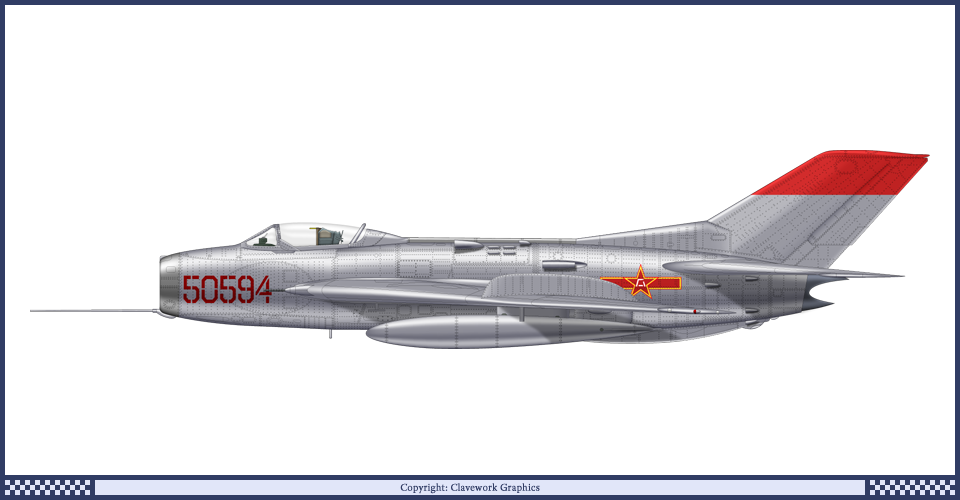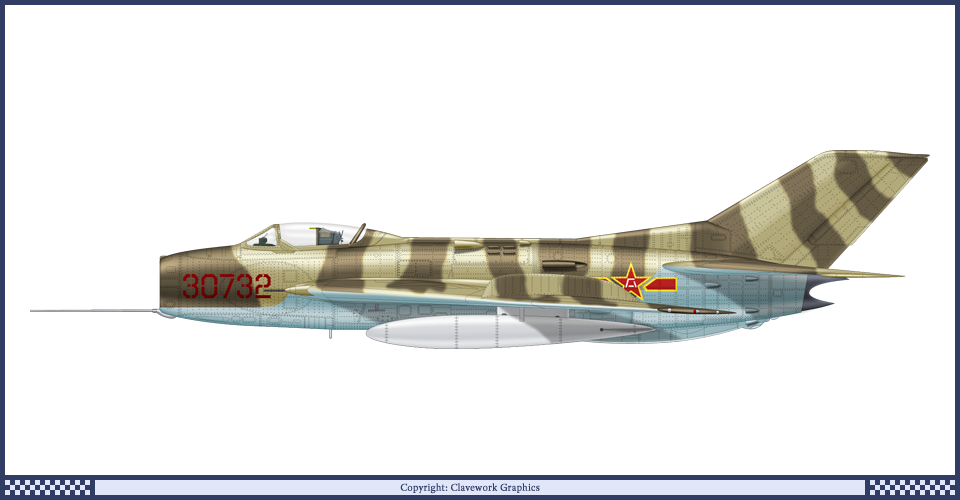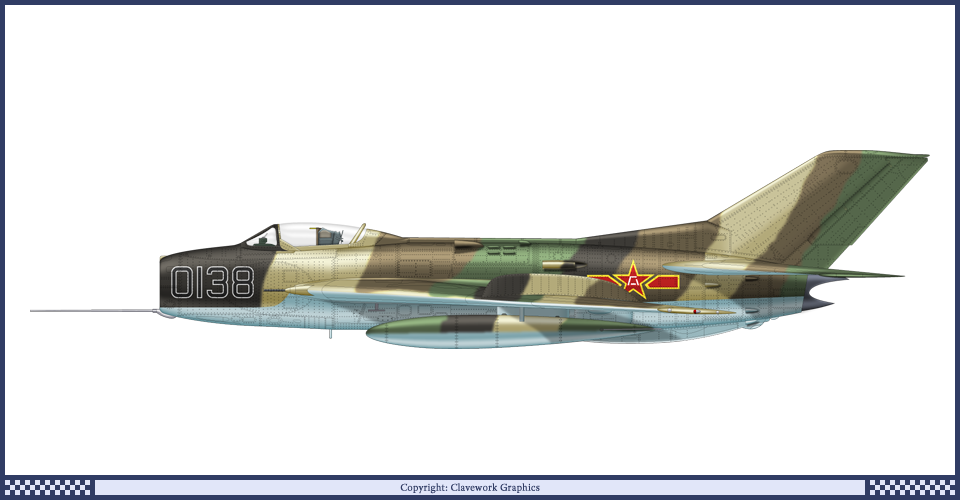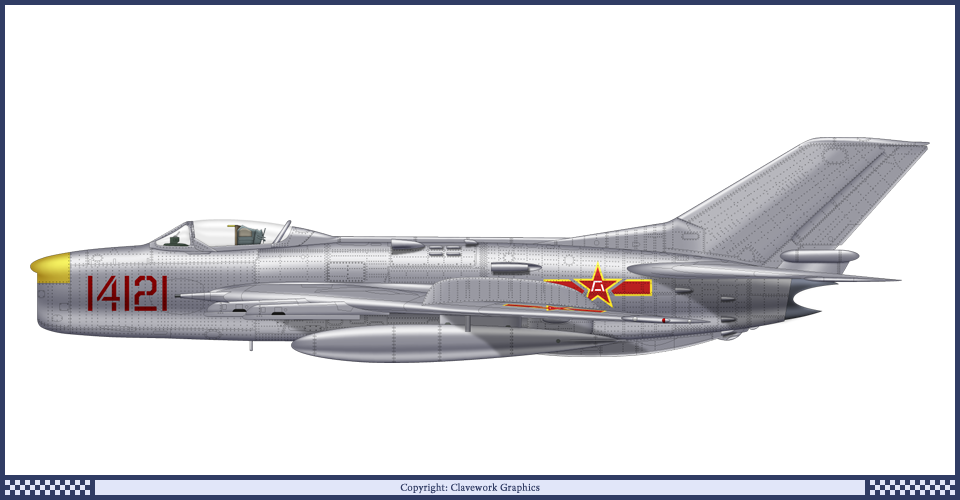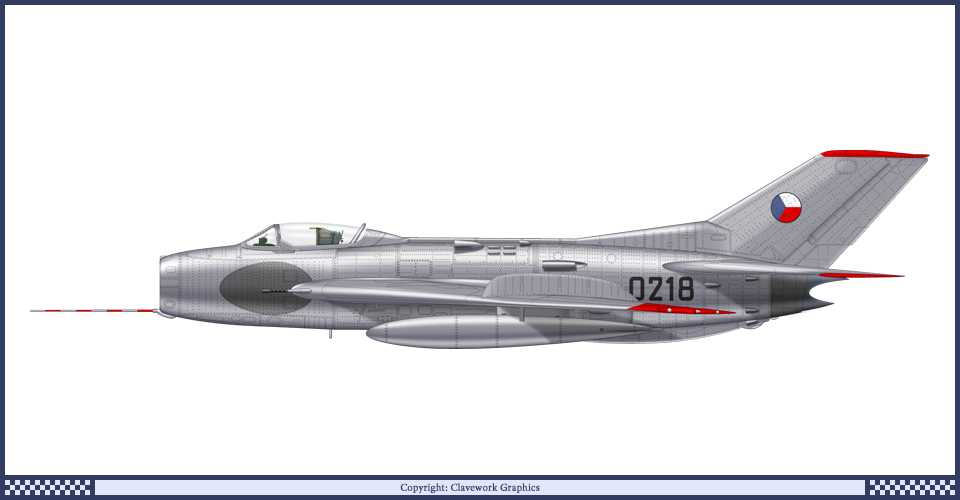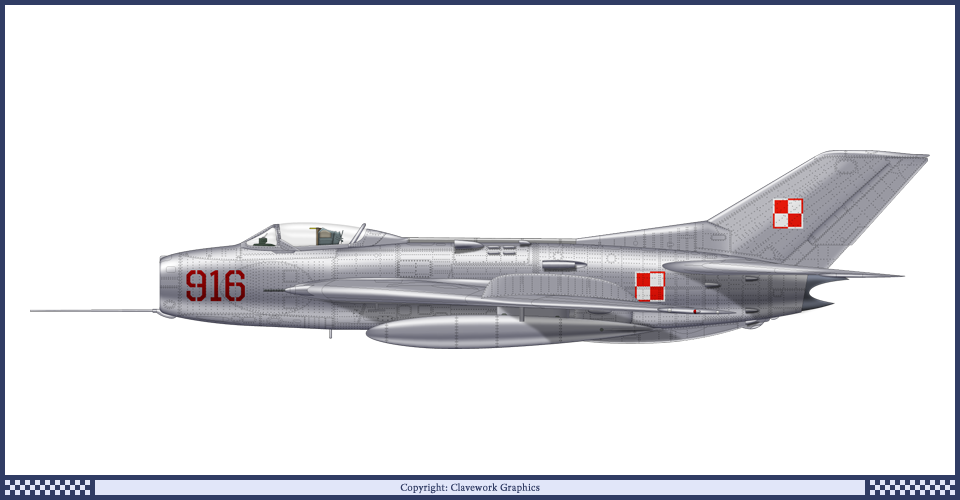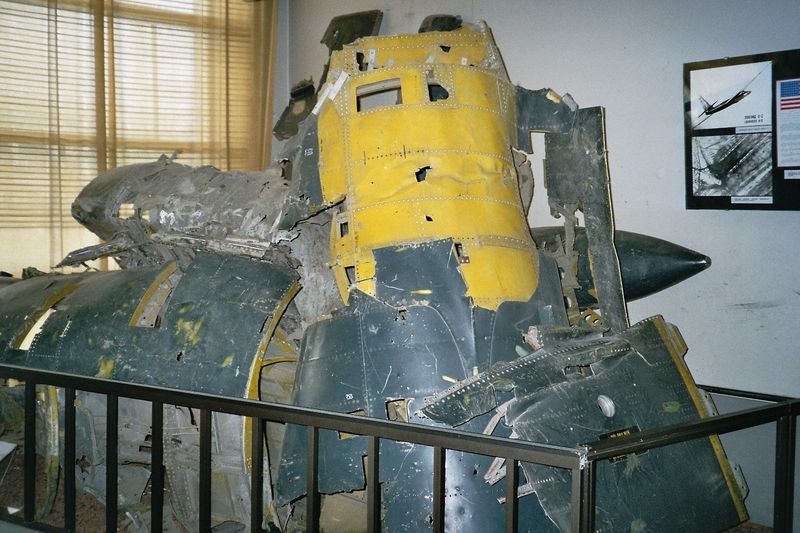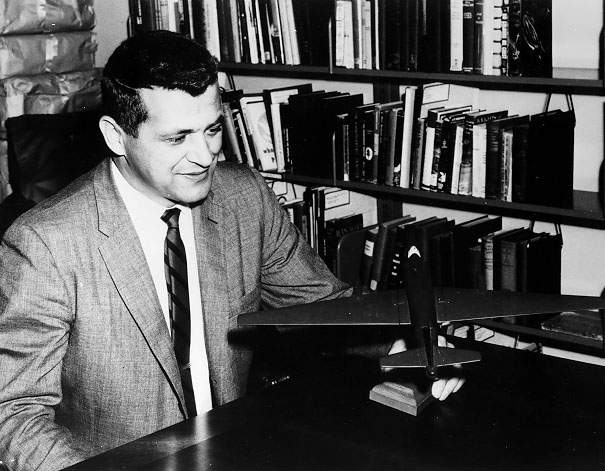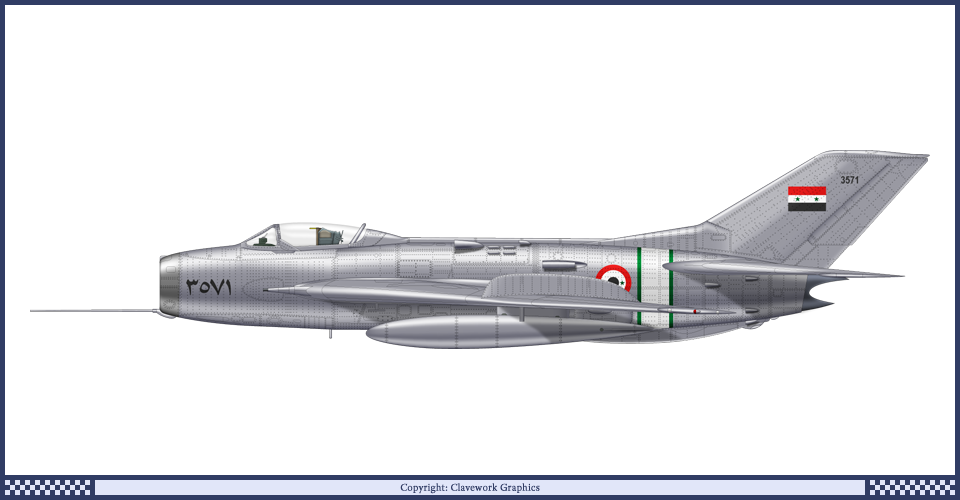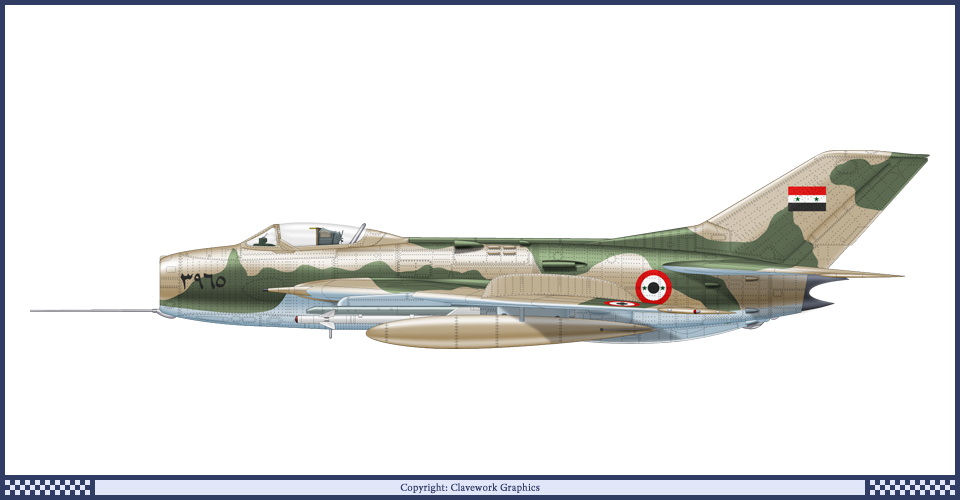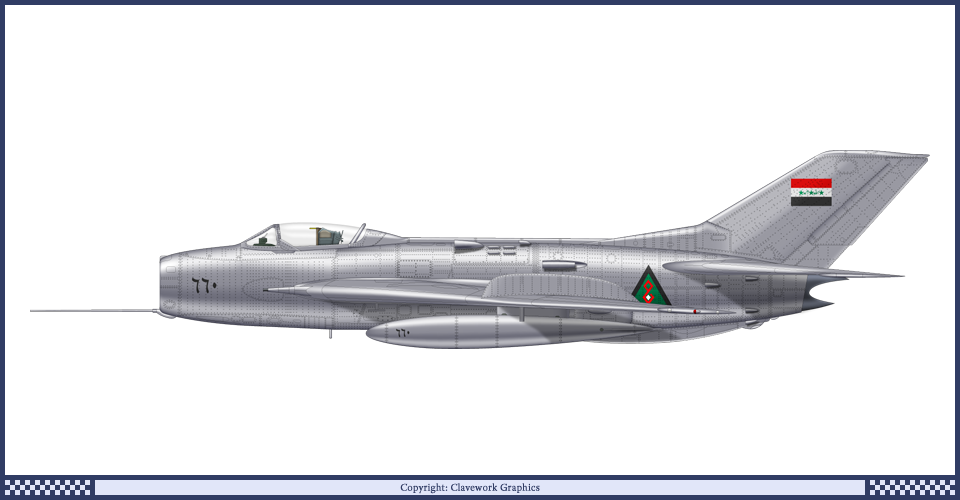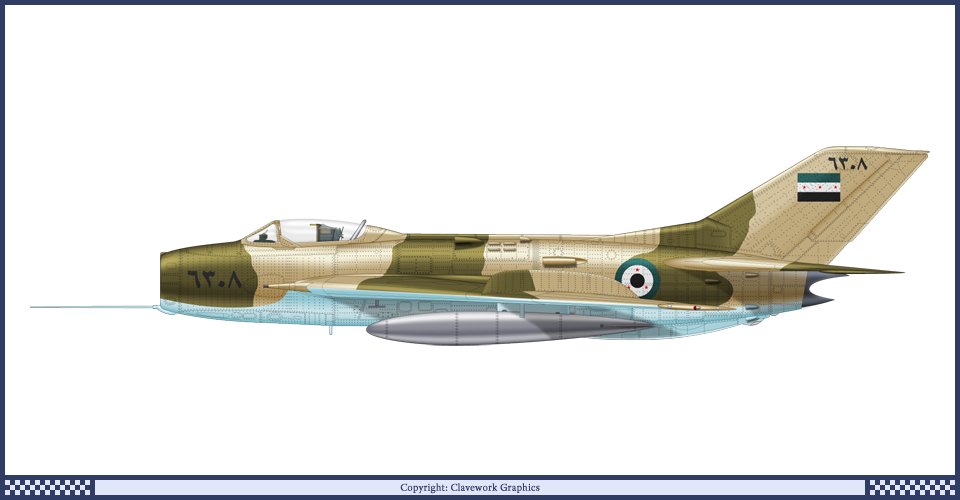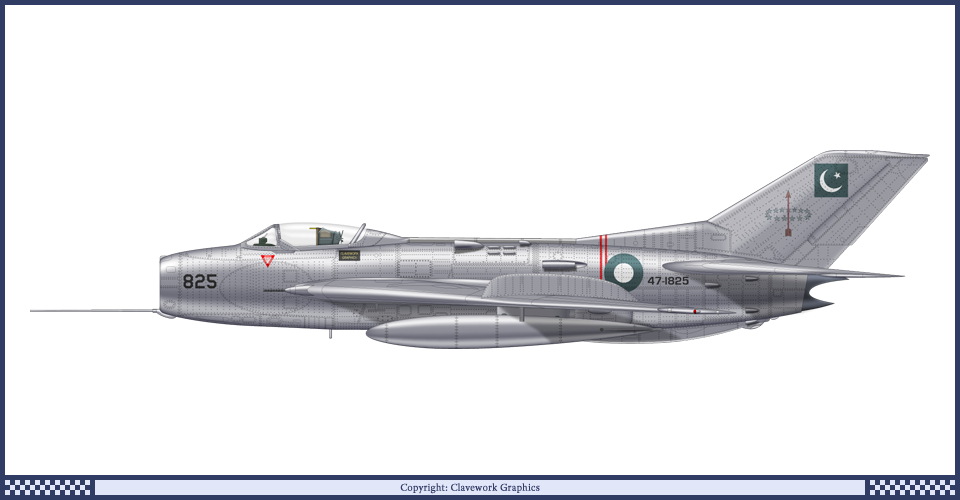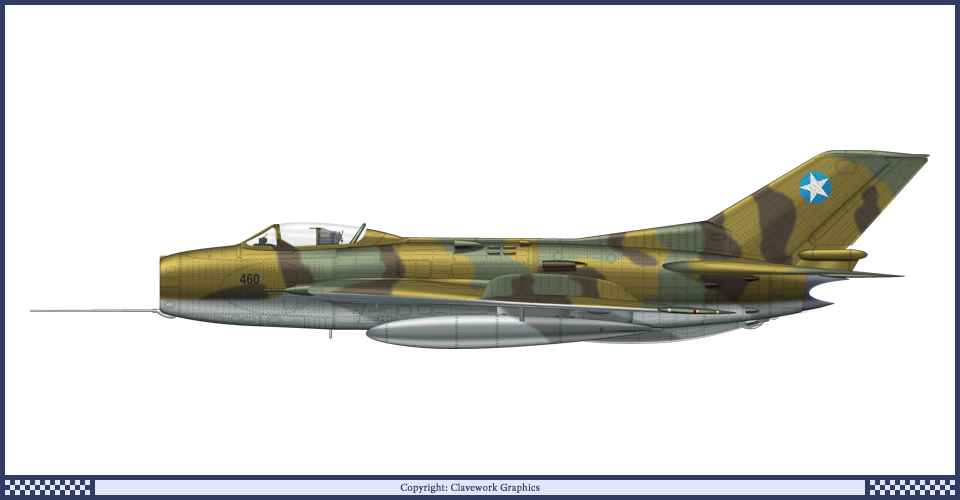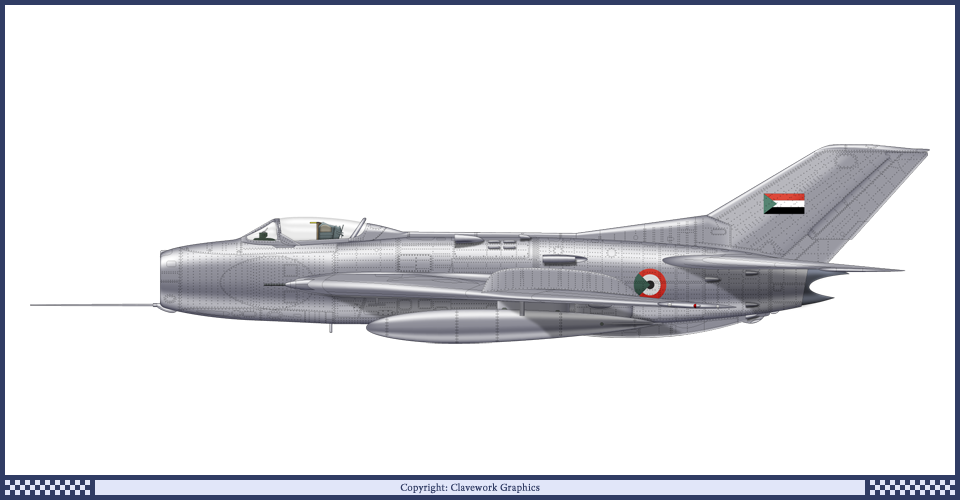MiG 19 First soviet supersonic aircraft
Version Francaise ICI
MIG 19 Profiles from Clavework Graphics Website
Walk around 1
MIG-19 ORIGINS
It was the first soviet second-generation, single-seat, twin jet engine fighter aircraft. It was the first Soviet production aircraft capable of supersonic speeds in level flight
Even as the MiG-17 was going into service, Soviet give way to a program of a new fighter a single-engined version with the Klimov VK 7 and a twin-engine version with Mikulin AM 9 F
MiG OKB on April 1951, receive an order to develop a new fighter under 2 versions Single and twin-engine fighter powered by two Mikulin AM 5 non-afterburning jet engines (a scaled-down version of the Mikulin AM-3) with 19.6 kN (4,410 lbf) of thrust.
OKB began to work upon a new fighter the izdeliye M" or "I-350"
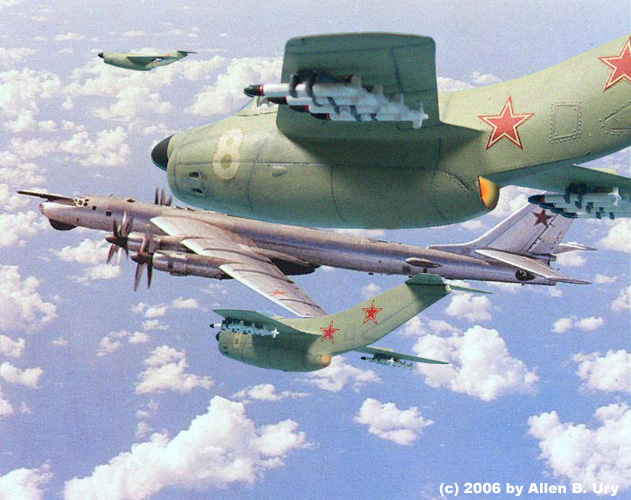 |
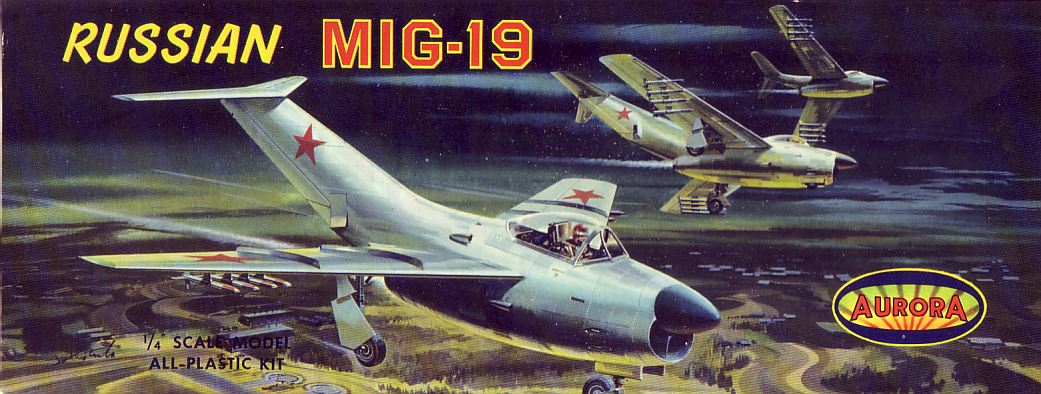 |
| Internet |
Internet |
This I 350 , receive the same armament of the MiG-15 and MiG-17, so a single 37 millimeter cannon and two 23 millimeter cannon.
His wing has a sweepback of 60 degrees plus tail surfaces with a similar radical sweepback, and a new Lyulka TR-3A / AL-5 axial flow turbojet engine.
Two prototypes were built in interceptor configuration were planned, one with RP-1 Izumrud radar performed its first flight on 16 June 1951, the other with Korshun radar but he The second prototype was never completed.
During the first flight the engine failing immediately after takeoff the fault to the AL-5 engine After correction of the problem I-350 program was axed in August 1951
Little after engine previous for the the MiG-17 SM AM-5F engine was put in twin on a new aircraft the izdeliye SM-2" or "I-360" long-range escort fighter, with development formally approved in August 1951.
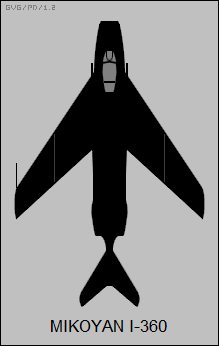 |
This I-360 was effectively a new aircraft, if he has some pieces of the MiG-17
It was powered by twin AM-5F turbojets, each providing an afterburning thrust of 26.5 kN (2,700 kgp / 5,950 lbf), and armed with a single N-37D 37 millimeter cannon in each wing root.
But faster armament was moved from the nose to the wingroots to reduce problems with engine intake gun gas ingestion,
Wing had a leading-edge sweep of 60 degrees; the aircraft featured a ventral fin and, initially, a tee tail arrangement.
3 aircrafts were built a static test airframe and two flight prototypes
First flight of the I-360 prototype take place on 24 May 1952, and 1 month after on 25 June he broke Mach 1 in level flight .
The2nd prototype performed its initial flight on 28 September. The tee tail arrangement proved unsatisfactory, losing control authority at high angles of attack, and so a conventional tail arrangement was fitted, with a larger tailplane fitted at the base of the tailfin instead of the top.
The reputation of products of the OKB MiG was very higth and VVS was always enthusiastic when a new MIG aircraft arrive so Mikoyan engineers are constrain to make better and they anted to perform a major redesign
Performance of the I-360 was good, but the design suffered from a number of clear deficiencies.
The first modification was Change of the engine ,using the new Mikulin AM-9B / RD-9B turbojet. The new design was receive the designation of "izdeliye SM-9".
Three SM-9 prototypes were built, with the initial flight of the first prototype on 5 February 1954 but since mid-February 1954 and he was a common Soviet practice, the type was ordered into production as the "MiG-19" in, well before the trials were completed, with the VVS looking forward to the service's first true supersonic fighter. The first two production MiG-19s were delivered to the VVS in June 1955, with 48 of the machines performing a flyover at the Tushino air show in August. NATO assigned the MiG- aircrafts19 the codename "Farmer The second and third prototypes were lost in accidents in 1956
In the same time Mikoyan OKB built a parallel fighter design with a single Klimov VK-7 centrifugal-flow engine The VK-7-powered fighter had flight surfaces like those of the SM-9 but a somewhat more slender fuselage; it was given the designation of "Iizdeliye -370"
but he was never built because the engine was tested during a long period and Finally he engine finally became available, and I-370 make its initial flight on 16 February 1955 Its performance was actually very good, but the technology choose for this engine were clearly not the way of the future for high-speed aircraft, and the test program was simply abandoned
Description
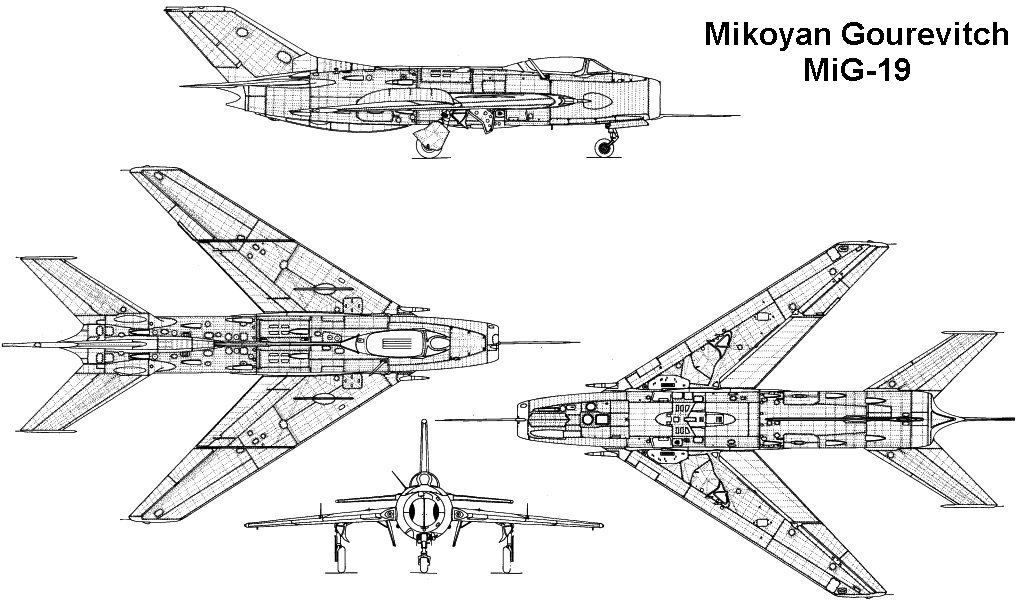 |
| Internet |
It is a big MiG 17 Many of deficiencies had been recognized during flight trials, but since the aircraft had been rushed into production before testing was complete, they had to be fixed in service
New fighter, internally designated "SM-1", was designed around the "SI-02" airframe MiG-17 prototype modified to accept two engines in a side-by-side arrangement
MiG-19 was made of aircraft aluminum alloy and rear fuselage could be pulled off just aft of the wingroots to expose the twin RD-9B turbojets for servicing A brake parachute was stored under the tail There was a small rubber bumper just aft of the ventral fin to protect the tail in case of "over-rotation" on takeoff
.jpg) |
.jpg) |
| Cockpit Internet |
Cockpit Internet |
At the beginning MiG suffered from poor cockpit pressurization and the engines proved temperamental with frequent flameouts and surges with rapid throttle movements.
The pilot sat on an ejection seat under a rearward-sliding canopy. The cockpit featured armor plating and an armor glass windscreen.
Avionics included radios, IFF, gyromagnetic compass, radio automatic direction finder, instrument landing system, radar-assisted gunsight, and a Sirena-2 RWR.
We found the long nose pitot probe fitted to the bottom lip of the engine intake, with the probe hinging upward on the ground so people wouldn't walk into it.
The engines were upgraded of thrust each, which exceeded the power output of the Klimov VK 1 in afterburner while providing better fuel economy.
But is SM-1 was barely supersonic, reaching 1,193 km/h at 5,000 m ,this performance was deemed insufficient for the new generation of supersonic fighters and an afterburning version of the engine, the AM-5F, was proposed. This engine served as the basis for the Tumansky RD 9 which powered production aircraft.
.jpg) |
| Rear exhaust pipes Internet |
But this aircraft has another problem and he was the most alarming The MiG-19, since it had an unfortunate tendency to explode in mid-air. The problem was finally traced All internal fuel was carried in four fuselage tanks and this fuel tank were placed under the engines that could cook up when the engines overheated; there was no room for tanks in the thin wing
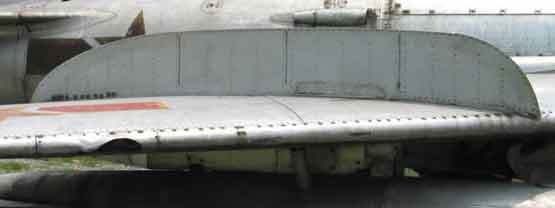 |
| Wings Internet |
. So we found a danger of a midair explosion due to overheating of this fuselage fuel tanks located between the engines.
It had strongly swept mid-mounted wings; a conventional swept tail assembly with a forward tailfin fillet; and a ventral fin under the tail. The control surface arrangement was conventional, with a single flap under each wing inboard of a prominent wing fence and outboard ailerons. The tail featured conventional rudder and elevators. There were twin dive brakes under the fuselage behind the wing.
.jpg) |
.jpg) |
| Ventral Airbrake Internet |
Airbrake Internet |
Deployment of airbrakes at high speeds caused a Hight/G pitch-up. Elevators lacked authority at supersonic speeds. And finaly the high landing speed of 230 km/h ) compared to 160 km/h was only resolved with the second prototype, "SM-9/2", which added a third ventral airbrake and introduced all-moving tail planes with a damper to prevent pilot-induced oscillations at subsonic speeds the tricycle landing gear had single wheels, with the nose gear retracting forward and the main gear hinging in the wings to retract towards the fuselage.
 |
.jpg) |
| Landing gear Internet |
Landing gear Internet |
.
Armament consisted of three NR-23 23 mm cannon, one in the right underside of the nose and one in each wing root.
.jpg) |
| NR-23 23 mm cannon Internet |
There was a small blast panel on each side of the fuselage to protect the aircraft from the muzzle blast of the wingroot cannon, though it seems that this panel was not included on all production. There was a stores pylon under the middle of each wing that could be used to carry bombs or rocket pods but, as far as the photographic evidence shows, usually carried a 760 liter external tank. Two pylons could be fitted inboard of the external tank pylon on each wing for carriage of unguided rocket pods, giving a typical external load for a ground attack mission of two external tanks and four rocket pods
.jpg) |
| External Tank Internet |
Variants (Wikipedia)
MiG-19 (NATO: "Farmer-A")
First production version armed with 3 × 23 mm NR-23 cannons.
MiG-19P (NATO: "Farmer-B")
 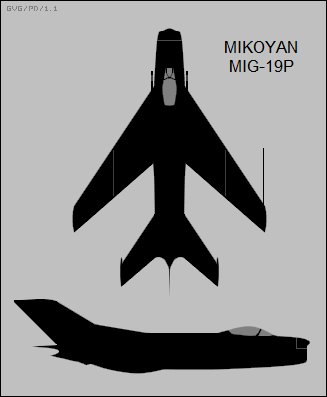 |
| MiG-19P: no cannon in early version Internet |
the interceptor variant entered production in 1955 as the "MiG-19P" and went into service mostly with the PVO, though the VVS and even the Red Navy operated a number of them Aside from the new radar nose, revised cockpit, and deletion of the fuselage cannon, the MiG-19P was similar to the MiG-19S, with the long tailfin fillet and all-moving tailplane. It was a bit draggier than the MiG-19S and performance suffered slightly . It was assigned the NATO codename of "Farmer-B".
Soviet pilots had not been all that happy with the MiG-19S, and they were in general even less happy with the MiG-19P not merely because of the slight degradation in performance, but also because the view from the radar-equipped cockpit was substantially worse and because of the unreliability of the radar.
. Late production machines had the improved RP-5 Izumrud radar, with greater range and better reliability Early production MiG-19Ps were equipped with RP-1 Izumrud radar in the nose and armed with 2 × 23 mm NR 23 (later 2 × 30 mm NR 30) cannons in the wings
"Farmer-Bs" often carried a single unguided rocket pod under each wing for air-to-air attacks. Late in their service lives, some MiG-19Ps were modified to carry the K-13 / AA-2 Atoll Sidewinder AAM clone on a new outboard pylon
MiG-19PG
A number of MiG-19Ps were fitted with the Gorizont-1 ground-control datalink, which provided guidance information to direct a fighter to a target, and were redesignated "MiG-19PG
MiG-19S (NATO: "Farmer-C")
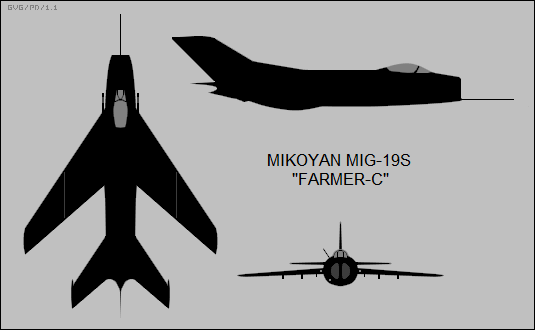 |
| MiG-19S: 3 NR-30 cannon w/201 rounds Internet |
An improved version of the MiG-19P introduced into manufacturing in 1956. It was given the NATO codename of "Farmer-C"
The MiG-19S featured tweaks overall, particularly in the form of a larger tailfin fillet to improve directional stability; an "all moving" or "all flying" slab tailplane, with small anti-flutter weights on the tips that gave it a distinctive barbed appearance -- these barbs would become a common feature on Soviet high-performance aircraft of the era; a third ventral airbrake just behind the ventral fin; and a range of small aerodynamic modifications. There were a few avionics improvements, including a new radio, improved gunsight ranging radar, and a "Svod (Dome)" long-range air navigation system receiver. Although early MiG-19S production retained the three NR-23 cannon, most were built with three much more formidable NR-30 30 millimeter cannon with muzzle brakes. Larger blast panels were fitted to the sides of the fuselage to protect the aircraft from the muzzle blast of the wing cannon. MiG-19R
Reconnaissance version of the MiG-19S with cameras replacing the nose cannon and powered by uprated RD-9BF-1 engines.A small number of MiG-19S machines were built in a reconnaissance configuration, with the fuselage cannon replaced by a camera payload. These aircraft were given the designation of "MiG-19R" and featured uprated RD-9BF-1 engines, with about 10% more dry thrust and an improved afterburner system
MiG-19SF
.jpg) |
Late-production MiG-19S fighters were also built with RD-9BF-1 engines, with these aircraft designated "MiG-19SF
MiG-19SV
USA use balloons to spy on the USSR so USSR built a High-altitude version for interceptin g this reconnaissance balloons with a variant of the MiG-19
A lightened MiG-19S with reduced armament, no cockpit armor, no brake chute, and so on, fitted with uprated RD-9BF engines. The type was put into limited production in 1956 as the "MiG-19SV",This aircraft piloted by N.I. Korovushkin achieving a world altitude record of 20,740 meters on 6 December 1956, reached 20,740 m (68,045 ft) on 6 December 1956; entered service in 1956.
MiG-19SVK
A single "MiG-19SVK" that was similar but had a new, wider-span dogtooth wing was tested in 1957. It was only able to climb a few hundred meters higher than the MiG-19SV but it was abandoned
MiG-19SU (SM-50)
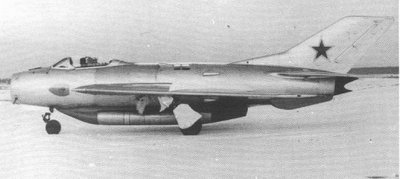 |
High-altitude version to intercept the Lockheed U-2, equipped with a self-contained liquid-fuel booster rocket pack; appears to have been abandoned because of inability to control the aircraft at very high altitudes and the aircraft's tendency to enter supersonic spins. By this time, the US had obtained a much better reconnaissance platform than balloons, the Lockheed U-2 "Angel" spyplane, which could cruise over the USSR at altitudes beyond the reach of any Soviet fighter, including the MiG-19SV. The first overflight of the USSR by a U-2 was on 4 July 1956, US independence day, as if taunting the Soviets -- though in fact the Americans were surprised when Soviet radars spotted the machine, the belief being that the U-2 would be effectively invisible to the radars the Soviets possessed at its operating altitude. Shooting the U-2 down was a high priority, and so the Mikoyan OKB investigated fitting the MiG-19S with a liquid-fuel rocket booster. The result was the "MiG-19SU".
The liquid-fuel booster was carried as a pack on the belly. Ground clearance was narrow and so takeoff rotation had to be shallow. The pack was self-contained, requiring only electrical and mechanical attachment connections to the aircraft, but some airframe reinforcement was needed to handle the thrust stresses. The rocket worked well as far as that went, but storable liquid propellants as a rule are corrosive and toxic, and storable fuel and oxidizer generally have the interesting feature of catching on fire spontaneously when mixed together. This made the rocket pack somewhat troublesome and dangerous to deal with. The MiG-19SU could indeed reach the operating altitude of a U-2. The only problem was that it couldn't really do very much once it did. At such altitudes, even the U-2, with its sailplane wings and light airframe, was barely aerodynamic, on the edge of stalling, and only the very best pilots could fly the thing. The MiG-19SU was about as aerodynamic and controllable as a brick once it reached such altitudes, and the turbojets were likely to flame out in the thin air. All a Red pilot could do was basically take a running jump up towards a U-2 from lower altitude and hope he could score a few hits before the fighter reached the top of its arc and fell (or more likely tumbled) back down again. It must have been an exciting ride, however
MiG-19PF
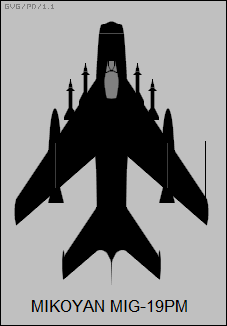  |
| MiG-19PFM, has no cannons but rails for four RS-2U missiles. Internet |
Single-seat radar-equipped, all-weather interceptor fighter aircraft; built in small numbers.
MiG-19PM (Farmer-E)
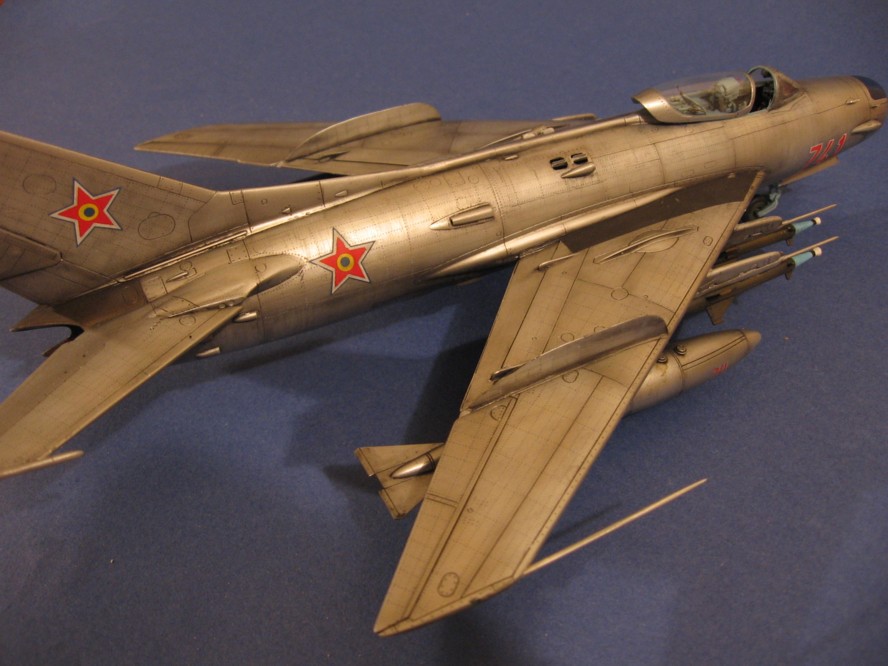 |
| Internet |
Work began also in 1956 on a missile-armed variant of the MiG-19P. Two of the MiG-19P prototypes were modified for trials, and the new variant entered service in 1957 as the "MiG-19PM". The variant was assigned the NATO codename of "Farmer-E"-- there doesn't seem to have been a "Farmer-D
This variant was very similar to the MiG-19P except that the cannon armament was removed, to be replaced by four K-5M / RS-2 / AA-1 Alkali beam-riding missiles. The RP-1 Izumrud radar was upgraded to the PR-2U variant, which provided control capabilities for the AAMs. The MiG-19PM was even more disliked than the MiG-19P, since the draggy missiles cut into performance substantially, and the K-5M AAMs were nothing to write home about as armament. ". Entered production in 1957
MiG-19PML
. A few MiG-19Ps were modified to a MiG-19PM standard, though these aircraft could only carry two AAMs. A number of MiG-19PMs were fitted with the "Lazur (Prussian Blue)" ground control datalink in the 1960s.
MiG-19PU
 |
it is a MiG-19P with a rocket pack similar to MiG-19SU., They were not effective mostly aftet the U-2 of Garry Powers shoot donw but a high-altitude "S-75 Tunguska ( SAM-2) on May 1st 1960,USA canceled this missions and use satellite reconnaissance capability to obtain photographic intelligence
MiG-19PT
A single MiG-19P equipped to carry Vympel K-13 (NATO: AA-2 "Atoll") missiles.
After the end of the MiG-19's service life, a number of "Farmer-A" and "Farmer-C" fighters MiG-19 and MiG-19S were converted to target drones. These machines were given the designation of "MiG-19M".
MiG-19 Refueling
A number of MiG-19s were modified for hose-and-drogue refueling trials, using probes on the wingtip, or on the nose, or on the side of the nose. As with the MiG-15 and MiG-17 trials in midair refueling, the concept seemed workable but it ended up too low on the priority list. No MiG-19 machines ever used inflight refueling in service.
MIG 19 UTI
Training Version
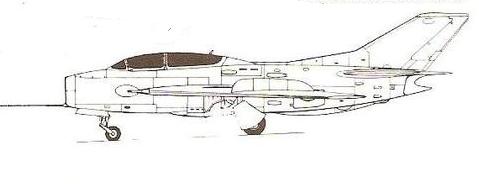 |
SM-6
Two MiG-19 Ps converted to flying laboratories for testing the Grushin K-6 developmental AAM (intended for the Sukhoi T-3 jet fighter) and Almaz-3 radar.
SM 7
It is a prototype of an a interceptor radar-equipped interceptor variant . The first of three "SM-7" prototypes of the variant performed its initial flight on August 1954The SM-7 featured a redesigned and longer nose with RP-1 Izumrud radar and the fuselage 23 millimeter cannon deleted, the two wing cannon being retained
SM-12
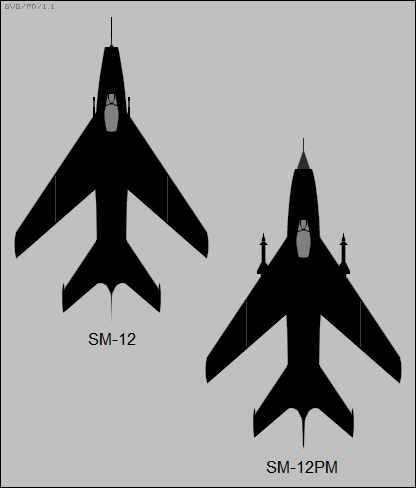 |
 |
| Internet |
Internet |
New fighter prototype, developed into the MiG-21; four aircraft built
By the mid-1950s, Mikoyan engineers were working on a lightweight fighter to follow the MiG-19, with this concept emerging in a few years as the MiG-21 "Fishbed". Since the MiG-19 was still in production at the time, the designers decided to leverage the advanced "sharp lipped" intake design of the new fighter into the older aircraft, The result was the "SM-12" series of prototypes. Four prototypes were day fighter machines, performing flight trials in 1957. They were along the lines of the MiG-19S but with a MiG-21 day fighter nose, with a small intake cone. They featured a number of small airframe improvements; a varying fit of improved avionics; and Sorokin R3-26 turbojets, though not all four of the aircraft were fitted with the Sorokin engines at all times, retaining the AM-5F engines in some instances. A single "SM-12PM" interceptor variant was flown in 1958, featuring a longer MiG-21 interceptor nose with a large intake cone containing the improved TsD-30 radar. Cannon were deleted and the aircraft was armed with twin AA-1 Alkali AAMs; it was fitted with R3-26 engines and had a variable exhaust. An "SM-12PMU" variant was also flown in 1958. This machine was very similar to the SM-12PM, but was fitted with the jettisonable liquid-fuel booster designed for the MiG-19SU/PU. The SM-12s were interesting machines, looking something like hybrids of the MiG-19 and the MiG-21, which in hindsight is effectively what they were. However, the MiG-21 was clearly such a step forward that it outclassed even an improved MiG-19, and so the MiG-19 faded into history as far as the Soviets were concerned.
SM-20 izdeliye SM-20".
To test the missile Kh-20 Raduga cruise missile (NATO AS-3 Kangaroo) OKB MiG converte two early production MiG-19 to "missile simulators The Kh-20 was to be carried under the belly of a Tupolev Tu-95K four-turboprop "Bear" bomber, and the missile simulators were carried aloft and launched from the Tu-95K just as if they had been the real thing.
One of the simulators was unpiloted, the other piloted;
they receive a belly fairing for control avionics, a "fat" dorsal spine containing more avionics, and a lug on the back for attachment to the carrier aircraft. They were stripped of extraneous gear such as armament, and fitted with all-moving slab tailplanes.
SM-K izdeliye SM-20
The same mission as missile simulator for testing the Raduga K-10 (NATO: AS-2 "Kipper") cruise missile
SM-30Zero-length launch (ZEL) version with PRD-22 booster rocket. During the 1950s, both the US and the USSR experimented with "zero-length launch (ZEL)", which involved getting fighter aircraft into the air without a runway by fitting them with a big solid-rocket booster. A number of MiG-19S machines were built for ZEL operation, featuring an oversized PRD-22 booster rocket and twin ventral fins to permit mounting the rocket under the tail. These machines were designated "izdeliye SM-30" and were intended to be used in front-line theaters where runways might not be available. The scheme actually worked surprisingly well from a strictly technical point of view, pilots having few problems with "blastoff", but it was logistically and tactically cumbersome; the scheme was never adopted for operational service. The US program came to exactly the same dead end. The Mikoyan OKB also worked on a parallel program in which two solid-fuel boosters were fitted at an angle to provide a short-takeoff capability. The scheme never got to the trials stage.
Shenyang J-6
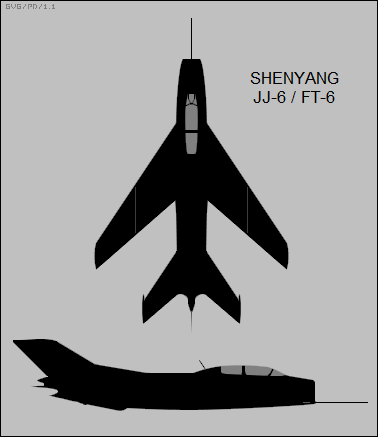 |
The MiG-19 appears to have been a basically sound design, with excellent performance, but was hobbled by implementation defects. As discussed below, the Chinese would effectively adopt it as their own and acquire an enthusiasm for it not shown by the Soviets
Chinese-built version of the MiG-19. This version was inducted into the Pakistani Air Force as the F-6. The F-6 was later modified by the Pakistani Air Force to carry U.S.-built AIM-9 Sidewinder missiles The Red Chinese would take ownership of the MiG-19 from the Soviets, but the Chinese got off to a slow start. Initial efforts at license production focused on the MiG-19P interceptor, with the Shenyang factory obtaining knockdown kits of the aircraft from the USSR in 1958, with the first Chinese-assembled machine flying in December of that year. The first Shenyang-built MiG-19P or "J-6" flew in September 1959.
The Nanchang factory also worked on assembly and production of the MiG-19PM in parallel, with the aircraft to be designated "J-6B", but the whole effort at both factories then fell down. Chinese leadership wanted to advance the country faster, and began a national "Great Leap Forward" that was driven by revolutionary rhetoric instead of methodical industrial planning. The results were a fiasco, with programs pushed ahead unrealistically until they all collapsed in chaos. Specific details of the Chinese effort to build the MiG-19P and MiG-19PM during this time remain tangled and obscure; what isn't obscure was that the effort was dismal failure.
After the collapse, Chinese industry picked itself up again and started over. Work on license-production of the MiG-19S day fighter at the Shenyang factory began in 1961, with the first Chinese-built machines flying at the end of the year. They retained the "J-6" designation. Production began to ramp up over the next few years, despite the fact that relations between China and the USSR deteriorated so badly in the early 1960s that the Soviets yanked all their technical assistance. Unfortunately, just as production was getting on track in mid-decade, China then entered into another period of confusion, this time caused by Mao Tse-Tung's "Great Proletarian Cultural Revolution", an attempt to radically restructure Chinese society along the lines of Chairman Mao's revolutionary ideals. The end result was vastly worse than that of the Great Leap Forward, featuring not merely industrial dislocation but widespread deaths due to famine and, apparently, purges of those judged not sufficiently enthusiastic with the regime's ideals. The production of the MiG-19S / J-6 managed to survive the horrors, and in the 1970s production ramped back up again. By that time it was basically an obsolete aircraft, but for the moment the Chinese didn't have the expertise to build a better one, and relations with the USSR remained frosty. The Shenyang factory built about 3,000 J-6s fighters into the 1980s, with large numbers exported under the designation of "F-6" to Chinese client states, particularly Pakistan. The J-6 remains in service with the PLAAF.
In maturity, the type was apparently regarded as thoroughly rugged, the early bugs having been worked out through long experience. Total production included a few subvariants:
J 6C, the late production standard for the day fighter, which was similar to the baseline MiG-19S / J-6 but had the brake parachute relocated from under the tail to a distinctive fairing under the tailfin, presumably along with a few other minor changes.
JZ-6", a reconnaissance variant with the fuselage cannon yanked and a camera payload fitted into the forward fuselage.
J-6III", an improved J-6 day fighter variant with uprated engines, a conical shock cone in the inlet, and shorter wings to improve maneuverability.
J-6A" or "J-6IV", an interceptor variant along the lines of the MiG-19PM, built in limited numbers.
The most distinctive Chinese-built variant was the "JJ-6" trainer, known as "FT-6" for the export market. As the J-6 became the standard day fighter for the People's Liberation Army Air Force (PLAAF), the MiG-17 derived JJ-5 became increasingly inadequate, and so work was performed to design a tandem-seat variant of the J-6C as a supersonic advanced trainer. It was strictly a Chinese aircraft; formally speaking, there was never a "MiG-19UTI". The fuselage was stretched 84 centimeters (33 inches) forward of the wings to accommodate the tandem-seat cockpit, which featured twin canopies that hinged open to the right. The wing cannon were deleted but the fuselage cannon was usually retained; the single ventral fin was traded for twin fins. Pakistan received a good number of FT-6 trainers, and in the 1980s set up a facility with Chinese help to refurbish them. The Pakistanis fitted their F-6s and FT-6s with Martin Baker Mark 10L rocket-boosted zero-zero (zero speed zero altitude) ejection seats. The Martin Baker seats not only improved safety, they also had a lower profile and allowed more headspace in the cockpit. Another Pakistani innovation was fit of US-built AIM-9 Sidewinder AAMs on an outer wing pylons. Pictures exist of the F-6 with this fit; it is unclear if the FT-6 was ever similarly equipped.
Chinese version F6
J-6, also called J-6A
Initial small-scale license production at Shenyang including kits, identical to the MiG-19P. Never accepted into service.
J-6B
License MiG-19PM built at Nanchang. Poor quality again, but some did make it into service. Basis for the Q-5.
J-6
Revived production of the Chinese FARMER, this time a radarless variant of the J-6/MiG-19P. It has the airframe and engine of the FARMER C, but the nose and armament of the FARMER B, although the latter ASCC is applied.
J-6C
As J-6, but with dragchute housing relocated into a pod under the tail and a few other minor changes.
JZ-6
Recce variant.
JJ-6
Trainer
J-6I
High altitude day interceptor: increased wing chord, two WP-6A turbojets, conical centrebody in the intake. Appearantly only with the underfuselage retained,
J-6II
As J-6I but with the wingroot cannons back in place, but no guns. Two R-3 license missiles only.
J-6III
The three-cannon variant of the J-6I/II, with a moveable intake centrebody.
J-6IV
Attempted all-weather J-6III by Shenyang with two cannons, and lightened airframe and systems. Totally unreliable, tended to break up during flight. Some 400 of this and the J-6IIIC were built, but had to be redesigned and rebuilt to eventually be airworthy.
J-6IIIC
Roughly like the J-6IV, but built by Guizhou.
J-6Xin
Appearant designation for the rebuilt J-6IIIC / J-6IV aircraft as they got accepted into service.
BW-1
FBW testbed.
NANCHANG Q-5 "FANTAN"
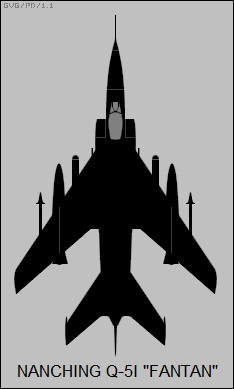 |
As mentioned, the Chinese Nanchang factory did work on license-production of the MiG-19 early on. The Shenyang factory ended up building most of the F-6s, but Nanchang did go on to build an interesting Chinese derivative of the MiG-19, the "Q-5", with the NATO codename of "Fantan".
Work on the Q-5 began in the early 1960s. The MiG-19 / J-6 was the most advanced aircraft China was able to produce at the time, and so it seemed a reasonable basis for a dedicated attack aircraft. The first prototype Q-5 performed its initial flight on 5 June 1965. Production was delayed by the Cultural Revolution, but by the 1970s the type was in large-scale production, and was exported to Albania, Bangladesh, Egypt, Iran, Iraq, North Korea, Pakistan, Somalia, Tanzania, Vietnam, and Zambia as the "A-5". It saw combat in the 1971 Indo-Pakistan War and during the Iran-Iraq War in the 1980s.
The Q-5 used the rear fuselage and landing gear of the MiG-19 / J-6, but featured a new forward fuselage with a pointed nose and side-mounted air intakes; the pointed nose was supposed to accommodate an attack radar, but the radar never materialized. The fuselage of the Q-5 was about 25% longer than that of the J-6. The wings were new, though they had the same sweep and general form-factor as the old, except for being "squared off" at the rear wingroot. Cannon armament consisted of a 23 millimeter cannon in each wingroot, a definite step back from the J-6. The variant history of the Q-5 remains obscure, but the initial production machine apparently had an internal weapons bay, and there is rumored to be a variant optimized for nuclear strike that retains the weapons bay. The initial production machine had three stores pylons under each wing, with the middle and outer pylons "wet", plus two stores pylons under the forward fuselage, for a total of eight stores pylons. Typical weapons included dumb bombs, cluster munitions, unguided rocket pods, and heat-seeking AAMs for self-defense.
The initial Q-5 led to the extended-range "Q-5I" in the early 1980s. The internal weapons bay was replaced by a fuel tank and two more stores pylons were added under the rear fuselage, bringing the total up to ten. The Q-5I also had a rocket-boosted ejection seat, uprated engines, a J-6C-style brake parachute pod at the base of the tailfin, and a number of minor engineering tweaks. The Chinese Navy flew Q-5Is, with these aircraft carrying two torpedoes or C-801 antishipping missiles, similar to the French Exocet. Since antiship missiles usually need to be targeted by radar, it is possible that targeting was performed in cooperation with some other platform.
The Q-5I was followed in production in the mid-1980s by the "Q-5IA", which had two more stores pylons, one on each outer wing, for AAMs, as well as an improved fueling system and updated avionics, including a sighting system. It was designated the "A-5C" or "A-5III" for export. The "Q-5II" was basically a Q-5IA with an improved countermeasures suite.
Technical data NANCHANG Q-5IA:
empty weight 6,375 kilograms
MTO weight 11,830 kilograms
wingspan 9.68 meters
wing area 27.95 sq_meters
length 15.65 meters
height 4.33 meters
Engine
max speed at altitude 1,190 KPH
service ceiling 15,850 meters
combat radius 400 kilometers
The total external load of a Q-5 was an unspectacular 2,000 kilograms and range was limited without external tanks. In addition, the avionics fit was basic by Western standards, and Chinese engines required overhauls far more often than contemporary Western engines. In compensation, the Q-5 was very cheap; it was also very sturdy and provided a smooth ride at low level, both big pluses for an attack aircraft. Pakistan was fond of the type, and as with their J-6s they refitted their A-5s with Martin Baker Mark 10 zero-zero ejection seats and wired them for Sidewinders.
In the late 1980s, the Chinese attempted to develop two improved variants of the Q-5. The first, the "Q-5M", was a collaboration with Aeritalia of Italy and was to feature the nav-attack and countermeasures suite of the Aeritalia-EMBRAER AMX light strike fighter. The second, the "Q-5K", was a collaboration with Thomson-CSF of France and featured a laser rangefinder in a chisel nose, a modernized cockpit, and a nav-attack system. The idea was to evaluate both variants and select one for production, but following the Tianemen Square massacre in 1989 an arms embargo was imposed on China, and that was the end of the matter. It is unclear if the Q-5 is still in production, though it is still in service
Others Productions
S-105 (MiG-19's in Czech service) Were these produced by the Czechs
The Czech Avia S.105s were indeed MiG-19S, they built 103 of those (got the full c/n list if you're interested). In addition, they recieved 13 Soviet-built MiG-19S, 26 MiG-19Ps and 40 MiG-19PMs making a pretty impressive MiG-19 fleet in that country. A lot of these later went to Bulgaria when MiG-21MF's started arriving. Don't know if the Soviet-built MiG-19s were called S.105 though.
LiM-7 (MiG-19's in Polish service) Were these produced by the Poles
Poland only got 19 MiG-19P's and 14 PM's in the late 1950s. At first these were deployed with mixed regiments at Mierzecice (ever been at that base when it was still the Polish AMARC? Great sight!) and Krzesiny. When MiG-21F-13s started arriving in numbers all went to the 28PLM at Slupsk.
They flew until 1976
MIG-19 IN SERVICE
The MiG-19's service in Soviet colors was transitory and not very significant. The most "action" they saw was with Western snooper aircraft probing around or into the USSR's borders. Possibly one of the best-known encounters was on 1 June 1960, when MiG-19 fighters shot down a Boeing RB-47H electronic reconnaissance aircraft that was probing around Archangel in the north, with four of the crew killed and two taken prisoner. They were released after a bit of international diplomacy. There were other shoot-downs by MiG-19s well into the decade.
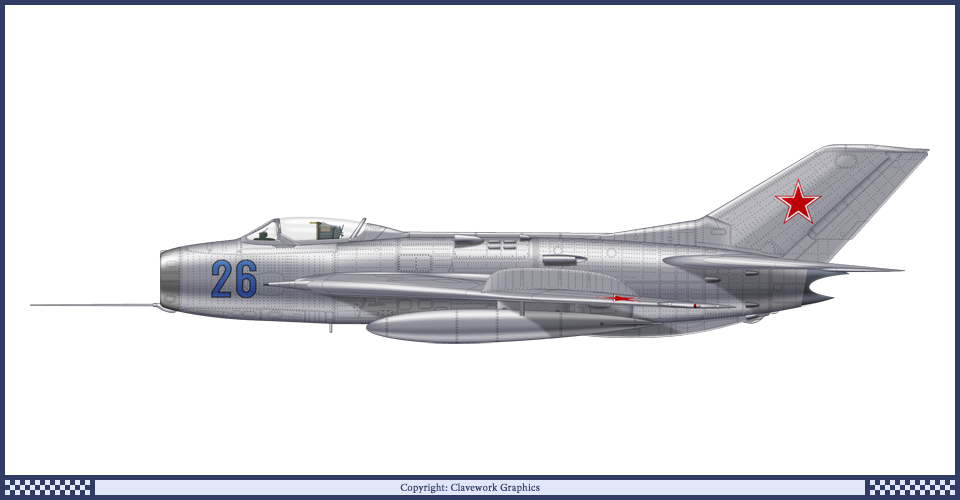 |
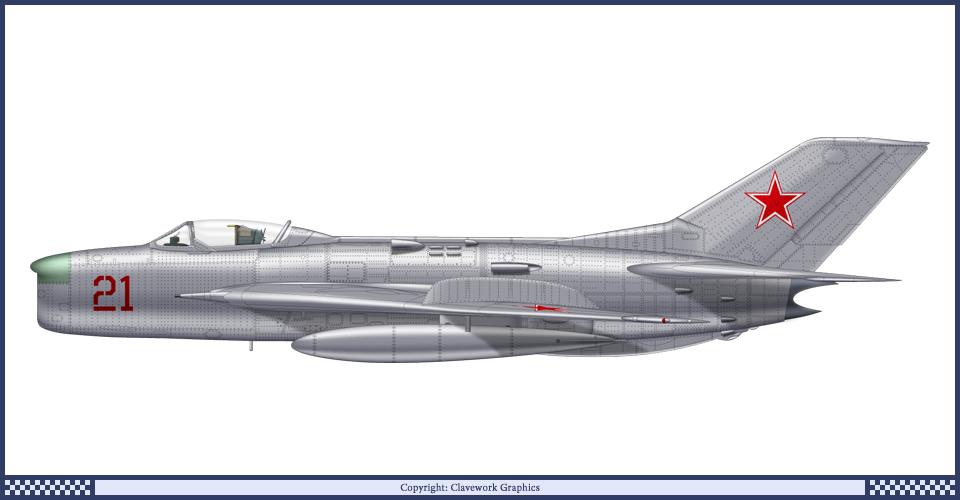 |
The MiG-19 didn't do so well against the Lockheed U-2. In 1957, a PVO MiG-19 pilot flying at the aircraft's ceiling spotted a U-2 flying far over his head. He reported the incident to the brass, who judged him a liar, and he ended up being transferred. However, it soon became obvious that he had been telling the truth, and MiG-19s spent years trying to take potshots at U-2s with absolutely no success. As mentioned, it was the SA-2 Guideline that actually put paid to the U-2 with the shootdown on 1 May 1960, but to compound the humiliation a MiG-19 was also shot down by an SA-2 during the incident, the pilot being killed.
The MiG-19 apparently was the mount of the Red Five flight demonstration team for a time, but the type was out of first-line service with the VVS and PVO by the end of the 1960s, though it lingered in secondary service well into the 1970s. Of course, by the time the MiG-19 was out of Soviet service it was still a mainstay of the Red Chinese, and saw a bit of combat in Chinese colors. Taiwanese aircraft were common adversaries. There was a big air battle between Red and Nationalist Chinese forces in 1967, with twelve J-6s taking on four Lockheed F-104 Starfighters. The MiGs got the worst of it, with two losses and no kills. There are also tales of Chinese J-6s flying combat missions during infrequent border squabbles with the Soviets, though with no records of dogfights; and of encounters during the Vietnam War with US aircraft that strayed into Chinese airspace. These confrontations resulted in a few shootdowns of Americans and, it seems, no losses of Chinese planes, though the MiGs sometimes had to make a hasty retreat back into Chinese airspace when the Americans flew in reinforcements. F-6s were supplied to North Vietnam late in the war, though the type didn't see much action compared the MiG-21 and particularly the MiG-17, with North Vietnamese F-6s performing a few dogfights in 1972, the last year of the real air war. It threw a curve at the Americans, being more agile than the MiG-21 but having better performance than the MiG-17.
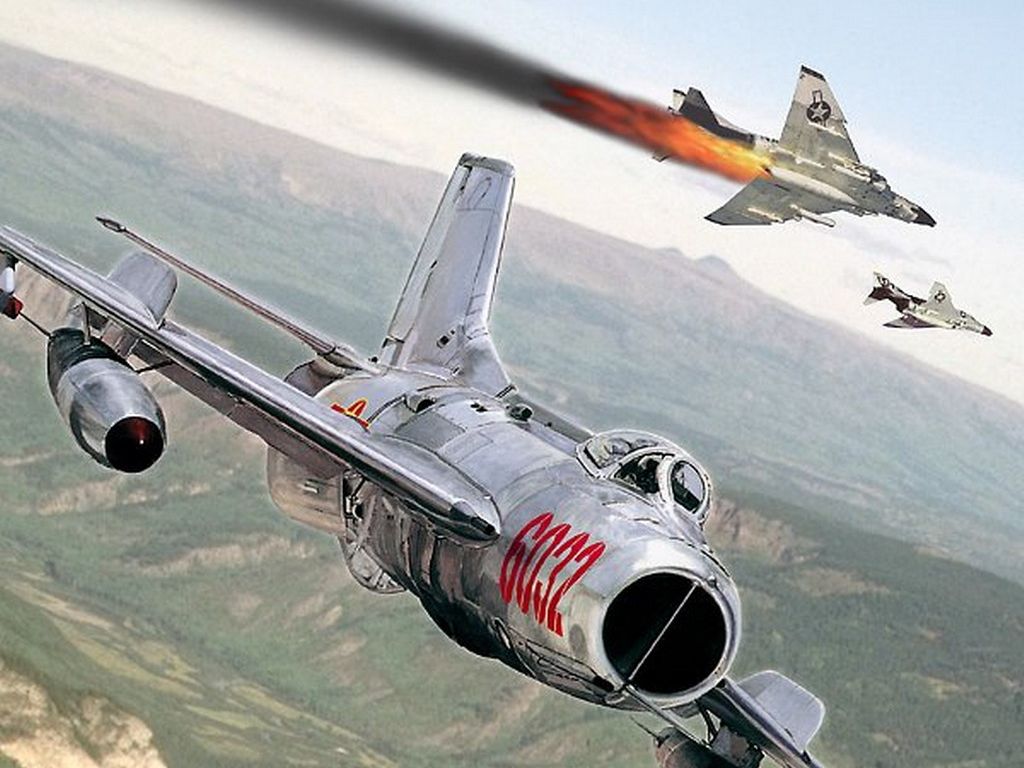 |
| Nam |
Cooperation between Chinese and Vietnamese is unusual, the two peoples having bitter animosities between each other measured in millennia, and after the end of the Vietnam War relations returned to their traditional surly status quo. In 1979, China performed a punitive military incursion into Vietnam in protest Vietnam's conquest of Cambodia. The operation did not go all that well for China, since the Vietnamese were thoroughly prepared for it, and at least one J-6 was shot down.
The MiG-19 saw some combat in the Middle East, with Egypt obtaining their first batch in 1958 and Syria receiving the type beginning in 1962. Egyptian MiG-19s saw some action in the ground-attack role in support of revolutionary forces during the civil war in Yemen during the early 1960s. The first reported air combat in the Mideast with the MiG-19 was on 29 November 1966, when two Egyptian MiG-19 fighters tangled it up with two Israeli Mirage IIICs. The Israelis claimed two kills and no losses to themselves. Many MiG-19s were in service with Egypt and Syria during the Six-Day War in 1967, but most were destroyed on the ground, and those that did survive were blown out of the sky by Israeli air superiority. Despite the unequal contest, Israeli pilots did find the MiG-19 a potentially dangerous adversary because of its performance, maneuverability, and heavy armament.
The Iraqis obtained some MiG-19S fighters in the early 1960s, but later sold them all off, though the survivors did see some action against the Kurds in the 1970s. In 1983, during the Iran-Iraq War, the Iraqis obtained a batch of F-6s through Egypt, while the Iranians acquired a batch of their own F-6s. Neither side made that much use of them during the conflict, and there are no records of MiG-on-MiG dogfights.
The most significant combat seen by the MiG-19 was during the Indo-Pakistan War in December 1971. The Pakistanis claimed that their F-6s shot down about ten Indian aircraft, with a loss of four F-6s. Of course, the Indians maintain that the Pakistani claims for kills are inflated and the number of losses are an underestimate. In any case, the Pakistanis felt the F-6s had acquitted itself well and expanded their fleet. During the Afghan War, Pakistani F-6s would scramble to deal with incursions of Soviet and Afghan aircraft into Pakistani airspace. The intruders were often in "hot pursuit" of Mujahedin guerrillas who were trying to escape back to their sanctuaries in Pakistan, and since it was an open secret that the Pakistanis were supporting the Mujahedin, sometimes the intruders didn't feel like leaving when they were challenged and there are tales of wild air battles. The Pakistanis didn't retire the F-6 until 2002.
The F-6 was supplied to a number of African nations. Tanzania flew the type against Uganda during the war between the two states in 1978 and 1979, while the Sudan used it against separatists in southern Sudan, with at least one shot down. The Somalis flew the F-6 against rebels and the Ethiopians in the 1980s, though with the breakdown in civil order in Somalia all their aircraft ended up derelict by the early 1990s.
Although the MiG-15 and MiG-17 are both well-represented in the private warbird circle, it is difficult to find any MiG-19s in private hands. No doubt the relative expense of operating and maintaining the type would make it too extravagant for all but the most prosperous of warbird pilot
Tehcnical Data MIG-19S
empty weight 5,760 kilograms
MTO weight 10,000 kilograms
wingspan 9.2 meters
wing area 25 sq_ meters
length 14.9 meters
height 3.88 meters
Engine
max speed at altitude 1,540 KPH
service ceiling 17,900 meters
combat radius 685 kilometers






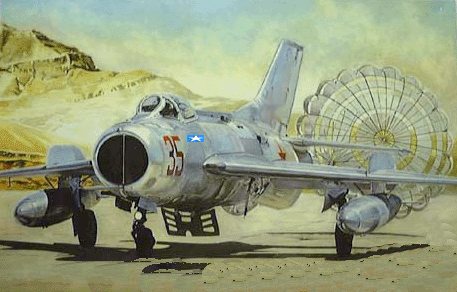




.jpg)
.jpg)
.jpg)

.jpg)
.jpg)

.jpg)
.jpg)
.jpg)



.jpg)
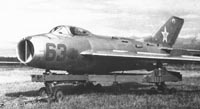



.png)



